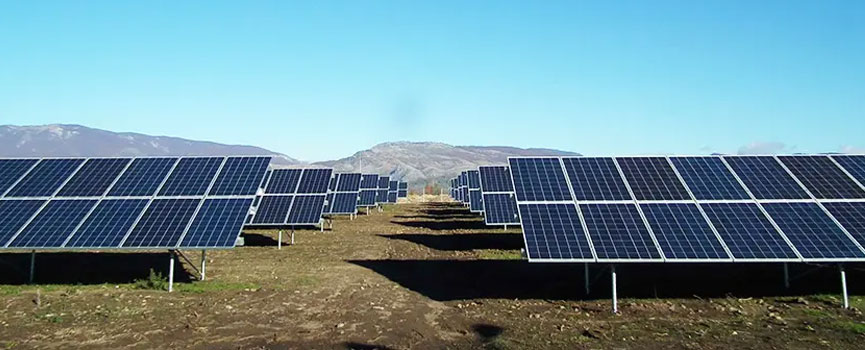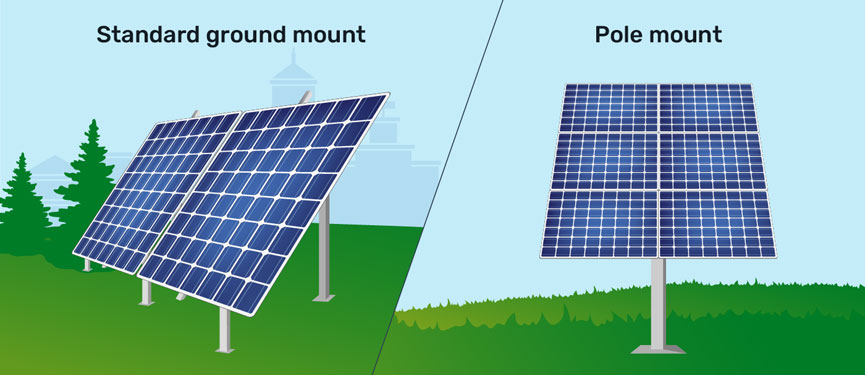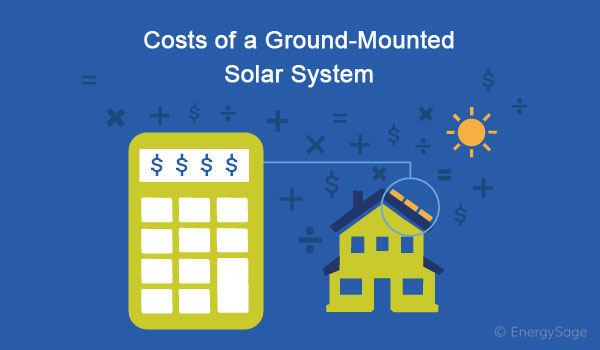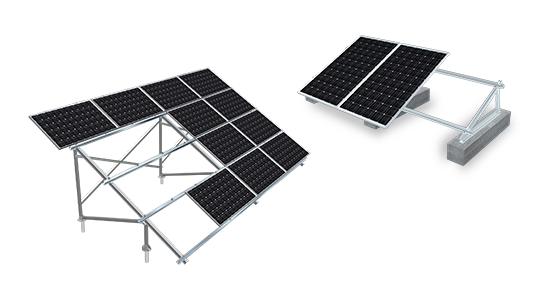Details of the Ground Solar Racking System

A solar racking system, is used to support a solar array on any surface, usually on a roof or directly on the ground. Ground-mounted systems can take the place of a rooftop system when the latter isn't available or suitable.
In this blog, we'll explain what a ground-mounted solar system is exactly, their pros and cons, and whether you should consider them for your home.
What is a ground-mounted solar panel system?
A ground-mounted solar power system is just what it sounds like - a system of solar panels that are mounted on the ground on your property, rather than on the roof of your house.
Ground-mounted solar panels can be installed any place on your property that has sufficient open space and good sun exposure. The panels can be placed anywhere from a few inches to a few feet off the ground, depending on how the racking system is set up. The panels feed power to a solar inverter, which is located either on the mounting system behind the panels or in the house.
Residential ground-mount solar installations are generally built using 60-cell solar panels - the same solar panel size typically used in residential rooftop solar installations. Meanwhile, larger-scale ground-mounted systems, like ones used in solar farms, tend to use larger, 72-cell solar panels.
Types of Mounts
You can use either a standard ground mount, which fixes the panels in one place, or a pole mount, which puts them higher off the ground.
On a roof, most mounts consist of a frame that is fastened to the structure of the roof's beams and rafters. If a roof-penetrating system is undesirable, such as on clay tile roofs, metal roofs, or a flat roof where water may pool, racking systems can be free-standing and ballasted.
Ground-mounted racking systems are either metal frames secured to a cement slab or are mounted on poles to allow for easier clearance below, such as in areas with heavy snow or in dual-purpose systems such as agrivoltaics, which integrate farming with solar panels.
Pole-mounted solar systems support multiple solar panels on a single pole and elevate panels higher off the ground than a standard ground mount. Pole-mounted solar often incorporates tracking systems, which automatically tilt the solar panels to capture the optimal amount of sunshine.
Tracking systems can increase the production of your solar panels by 25 percent or more. If you decide to add a tracking system to your ground-mounted solar array, you have the option of either a single-axis or a dual-axis system. Single-axis tracking systems move your solar panels over the course of the day to follow the sun as it moves through the sky. Dual-axis tracking systems can also adjust based on seasonal variations in the sun's position.
Most racking components in both rooftop and ground-mounted systems are made of high-grade aluminum and stainless steel. An important consideration is the strength of the racking, which needs to support snow and high winds in many areas. A strong racking system might support up to 90 pounds per square foot snow load and 190 mph winds.
What are the pros and cons of ground-mounted solar panels?
Here's what to consider if you're thinking about going solar with a ground-mounted solar panel installation.
Pros:
● Great way to bypass any roof issues, existing or potential (limited space, structurally weak roof, etc.)
● Higher energy production, as you can position your solar panels in the optimal direction and angle
● Easy to clean and maintain
● System is not confined to the dimensions of the roof
Cons:
● More expensive than a rooftop solar system
● Takes up valuable real estate
● Affects the home's overall aesthetic
● Requires a longer permitting process
The biggest advantage with ground-mounted solar panels is that they offer greater control over your solar panel direction and angle. Solar panels need to face either south or southwest to receive maximum direct sunlight. On the flat ground, you can position solar panels in any direction you want to maximize sun exposure, unlike on a slanted roof.
This advantage means ground panels often receive more sunlight, allowing them to generate more solar power, thus saving you more money.
Components Common to All Racking Systems
Solar racking systems come with inverters that convert the direct current (DC) electricity that solar photovoltaic systems produce into the alternating current (AC) that residential and commercial buildings run on. Those inverters are sometimes built directly into the racking system, but in most systems, they are attached with clips.
Wiring runs through a solar array within the mounting rails, connecting the electrical junction box attached to the back of the solar panel with the system junction box.
Lugs, bolts, end caps, end clamps, wire clips, brackets, and various other mounting hardware are also common elements of any racking system.
Costs of a Ground-Mounted Solar System
On average, a solar system is about $2.81 per watt, so a 6 kilowatt system (enough to power the average American household) would cost $16,860, including installation. The upfront costs of a ground-mounted system are greater, because they include the cost of a concrete foundation, extra mounting hardware, extra labor, extra permitting, and (potentially) a tracking system, which on its own can add $500 to $1,000 per panel to the entire system cost.
Any solar system is a long-term investment, so the most important calculation to make is not the upfront costs (though those are important) but the return on investment (ROI). Many factors go into calculating a solar system's ROI: the cost and efficiency of the panels, the cost of financing, local labor costs, federal and state incentives, and the price of electricity in your area, among others factors. The average time it takes for the system to pay for itself is 7 to 12 years.
The main factor determining whether or not a ground-mounted solar array is cost-competitive with a rooftop system is its efficiency. If it's able to produce more electricity using fewer panels, it may have a quicker return on investment.
Ultimately, the best decision for your photovoltaic array will depend on several factors — not just your out-of-pocket expenses. A professional contractor can help you weigh the benefits and drawbacks of each option and offer recommendations for the most cost-effective installation.


